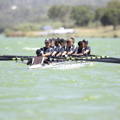Strength Training for Rowing
Strength Training for Rowing
Talking about rowing, you first have to define which specific sport is being trained for, like a canoe, crew work, or kayaking. All the different sports demand a significant amount of rowing. Some rowing sports ask you to row only to one side, others will ask you to perform bilaterally, and others will demand side-to-side with isometric work.
The main focus in all rowing sports is that skill and technique is paramount for your rowing development. Your strength training is a supplement to the skills being developed in the water to improve technique at an explosive speed.

As a rower using an ore, this first aspect you may find counter-intuitive. Working with canoeist Ian Ross, a top 10 in the world canoer, trains maximal strength with unique movements. For instance, you may focus on seal rows or maximal dead hang pull-ups to target the lats.
Rowers have to focus on a long big pull with maximal strength to be applied over a long range. Deadlifts and explosive clean pulls help develop maximal strength for rowing.
The next concept you need to understand is unilateral contrast training to best strength train for rowing events. Rowers have to be able to do things unilaterally. Movements like single-leg squats and box step-ups help push the maximal weight being used. You then do contrast movements explosively to allow you to become more coordinated and athletic. Contrast training potentiates the nervous system to put out a ton of force at a lower weight to teach the body’s nervous system to recruit more high-threshold motor units.
With that under your belt as a rower, you need to be as explosive as possible. The beginning phase of the race can establish the rest of the race. If you are good off the start with great strength endurance your ore breaking the water will provide greater power output to cover more distance with less energy expended.
Explosive work will make you as a rower better on the water. You need to do explosive pull-ups, muscle-ups, and drop seal rows. You can get creative on the glute ham machine holding an isometric position while performing different rows to develop explosive capabilities.
Leading to strength endurance in rowing, you have to know it comes down to being as explosive as possible over some time. You need to be able to handle that explosiveness over various distances and time domains. To do this, you will need mitochondria respiration.
Sprint interval training, high-intensity interval training, and long steady distance all play a factor in your strength endurance capabilities. You need to see where you are weak to identify which area to train relative to what else is being done in the weight room to train for rowing events.
The fifth factor is dynamic trunk control. Flailing all over the place is unacceptable. You need to hold a straight line. Having dynamic trunk control gives you great stability and posture in the boat.
Dynamic trunk control can be developed by using a hydro weight. You can even do front squats that force you to recruit throughout the core to develop dynamic trunk control to be better on the water. The idea is to train and stimulate dynamic trunk control endurance to hold that posture throughout the race.
Related Posts
Blog Topics

Yo, It's Dane
Welcome to the Garage Strength Blog, where it is my goal to provide you with the experience and knowledge I've gained in the strength and conditioning world over many years of learning from both successes and failures. I train elite-level athletes in a multitude of sports from the high school to professional levels, already producing 5 Olympics and 30+ National Champions. If you want to be the next champion I train, check out my strength programs below!
Start Training With Me

Join for free educational videos EVERY WEEK on strength coaching and athletic performance
